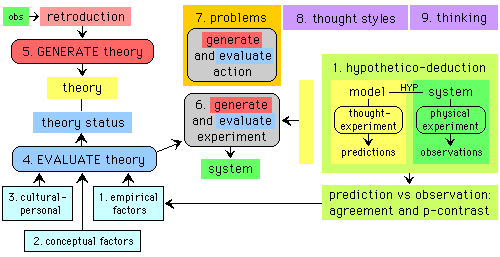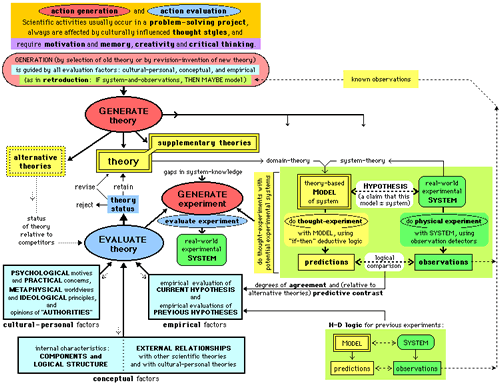My Original Model of Science Process
My current models for Science Process and Design Process are closely related because Science is a type of Design that has Theory Design & Experimental Design as its Main Objective & Sub-Objective.
This page describes the model for Science Process that I developed during my PhD work. And you can see it with increasing levels of detail in a Basic Overview & In-Depth Overview & my PhD Dissertation.
I think this original model was very good, and still is. It's accurate and logically organized, and it could be useful for education. But in the context of this website – about "Using Design Process for Education" – my current model is more relevant because it's more related to Design Process.
The Process of Science:
Science Process (scientific method)
My PhD project` was: 1) a unifying synthesis of ideas — mainly from scientists and philosophers, but also from historians, sociologists, psychologists, educators, and myself — into a comprehensive model of Scientific Method, and 2) an application of this model for an integrative analysis of a creative, award-winning science-inquiry classroom. My model is much different than an unfortunately common stereotype of Scientific Method (as an overly simplistic, rigid “5-step sequence”) and it's closely related to Design Process, so I'm calling it Science Process. Is there a method? - No and Yes
Nature of Science + Thinking-and-Actions: The goals for my model of Science Process were to accurately describe what scientists do, and help students understand the nature of science and the thinking & actions of scientists (and improve their own thinking & actions) in these 9 aspects of Science Process:
1. use Empirical Factors in Theory Evaluation,
2. use Conceptual Factors in Theory Evaluation,
3. use Cultural-Personal Factors in Theory Evaluation,
4. Evaluate Theories (with critical thinking), and
5. Generate Theories (with creative thinking);
6. Design Experiments (by generating-and-evaluating);
7. do Science Projects (planning and coordinating);
8. be influenced by Thought Styles (cultural & personal),
9. use creative-and-critical Productive Thinking.
Explorations (visual & verbal) of the 9 Aspects
 An Inquiry Activity: You can examine two representations of science — verbal (in the "9 Aspects" above) and verbal/visual` (with numbers, 1-9, in the right-side diagram) — that describe some relationships within and between four sub-categories: 12345, 6, 7, 89. Do you see symbolism in the colors (yellow & green & yellow-green, (red & blue), and different kinds of meanings for the arrows? Both are shown more clearly, with less word-abbreviation & concept-omission, and more details, in the bottom-of-page diagram that are easier to read in its non-photoreduced version.
An Inquiry Activity: You can examine two representations of science — verbal (in the "9 Aspects" above) and verbal/visual` (with numbers, 1-9, in the right-side diagram) — that describe some relationships within and between four sub-categories: 12345, 6, 7, 89. Do you see symbolism in the colors (yellow & green & yellow-green, (red & blue), and different kinds of meanings for the arrows? Both are shown more clearly, with less word-abbreviation & concept-omission, and more details, in the bottom-of-page diagram that are easier to read in its non-photoreduced version.
After you've explored for awhile, you can read my comments about color symbolisms and aspect-relationships:
As you can see in the diagram and in the descriptions below, arrows can show factors that influence Evaluation, or actions that produce results, or actions that motivate/stimulate other actions.
In the top diagram, one arrow points away from Experimental Design in the center (6. generate and evaluate experiments) because the objective is to design an experimental system; notice the other place "system" appears (hint: use color cues); two arrows point toward 6 because "Evaluate Theory" lets us recognize gaps in our knowledge (by thinking “if we knew , then our evaluation could be better”) and these gaps can be filled by information from experiments, and because thought-experiments (symbolized by the yellow bar, and described more completely in the detailed bottom-diagram) are essential actions when we design experimental systems.
Above 6, you see 7 (it's another generate-and-evaluate, in a design of actions) plus 8-and-9, which are simple in the diagram although there are many inter-relationships (with each other and with 12345 & 6) in an actual process of science.
The process-relationships are shown more explicitly for 12345, when we Generate Theories (5) and Evaluate Theories (1234) to Design Theories. For "Evaluate Theory" and "Generate Theory" the arrows (incoming and outgoing) have meanings, which are explained more clearly in the detailed-diagram. The logical foundation of science, Hypothetico-Deductive Reasoning, is outlined in "1" on the right side, where the colors (yellow, green, yellow-green) have meanings, and two types of empirical factors (agreement between predictions & observations, and predictive contrast for competitive theories) are shown for the current experiment and previous experiments.
MORE — Because my model shows the coordinated functional relationships between these 9 aspects of science by integrating their relationships
into a coherent framework, originally I called it Integrated Scientific Method, and now it can be Integrated Science Process. This integration is described visually-and-verbally in the diagrams, is described verbally below and (much more thoroughly) in condensations of my dissertation in a series of web-pages or in the full-length dissertation.
Verbal Descriptions of the 9 Aspects
• Designing Experiments (6) occurs by creatively generating ideas for experimental systems, critically evaluating these ideas, and choosing an experimental system to use for a Mental Experiment (to make Predictions) or a Physical Experiment (to make Observations), or both. {more about Designing Experiments}
• Designing Theories begins with creatively generating ideas for theories (5), which are evaluated (4) using evaluation factors (1, 2, 3) that are empirical, conceptual, and cultural-personal. {more about Designing Theories}
• Science Projects (7) are planned and coordinated (as with Design Projects, because science is design) by Choosing an Objective & Defining Goals, and Coordinating the Process of Science.
• Scientific Thinking in the other 7 aspects (above) is described by 2 of the aspects: during a process of science, thinking is influenced by the Thought Styles (8) of individual scientists who operate in the context of their societal cultures & scientific communities; and scientific progress is promoted by Productive Thinking (9) that effectively combines motivation, memory, creativity and critical thinking.
The Nature of Science — Differing Perspectives
This model of Science Process is a unifying synthesis of ideas about science, gathered from scholars in a wide range of fields. Therefore, it can be used to explain “the nature of science” from the perspectives of different disciplines (science, philosophy, history, sociology, psychology, education), and from the differing perspectives of individual scholars (and the sub-communities they form) within each area. How?
Framework + Elaborations: Due to the structure of my Integrated Science Process, it's a single model that "can be used to describe many types of scientific practices and many views of science" when we supplement the model's basic principles with details, using a teaching strategy of framework plus elaborations.
Science Process is a type of Design Process
As explained in Design and Science, science is a special type of design in which the main objective is to improve our understanding of nature by Designing Experiments and Designing Theories, as described above.
Because science is a type of design, Science Process is a type of Design Process that emphasizes, and has developed to a high degree, some of the 10 modes of action (mental and/or physical) in Design Process. This close relationship lets us describe Science Process in terms of Design Process, or (if you prefer) independent from it. And it helps us build Educational Bridges from Design to Science with strong transfers of learning, because when students have used Design Process — if they do design before science, as I recommend — they already have used most of the skills-and-methods in Science Process.
Objectives and Sub-Objectives — Theory Design and Experimental Design
In science, our ultimate objective is to design theories that are accurate representations of nature.
During this Theory Design an essential activity is Experimental Design because this lets us make the Predictions (in mental experiments) and Observations (in physical experiments) that we use in Reality Checks (Theory Checks) for Designing Theories. Improving our knowledge about nature (with experiments) is an essential foundation for improving our understanding of nature (in theories).
Although in science the long-term ultimate objective is Theory Design, the sub-objective of Experimental Design is very important in the everyday activities of scientists. (and in obtaining grants to fund their research)
Scientific Methods? — Is there a method for science?
No. There is no rigid sequence-of-steps that is used by all scientists, in all areas of science, at all times. The 9 aspects are not 9 steps.
Yes. Scientists have observed that their work tends to be more effective when they use “scientific methods” of coordinated thinking-and-actions, such as those described in my model of Scientific Method (Science Process).
This “no and yes” is examined in a page asking "Is there a method?" which looks at “methods” more closely, compares two kinds of skaters (one is analogous to the methods of science & design, the other isn't), and explains how one model of science can be customized to describe many types of science and many views of science, so teachers can customize their teaching of Science Process, and Design Process.
 An Inquiry Activity: You can examine two representations of science — verbal (in the "9 Aspects" above) and verbal/visual` (with numbers, 1-9, in the right-side diagram) — that describe some relationships within and between four sub-categories: 12345, 6, 7, 89. Do you see symbolism in the colors (yellow & green & yellow-green, (red & blue), and different kinds of meanings for the arrows? Both are shown more clearly, with less word-abbreviation & concept-omission, and more details, in the bottom-of-page diagram that are easier to read in its non-photoreduced version.
An Inquiry Activity: You can examine two representations of science — verbal (in the "9 Aspects" above) and verbal/visual` (with numbers, 1-9, in the right-side diagram) — that describe some relationships within and between four sub-categories: 12345, 6, 7, 89. Do you see symbolism in the colors (yellow & green & yellow-green, (red & blue), and different kinds of meanings for the arrows? Both are shown more clearly, with less word-abbreviation & concept-omission, and more details, in the bottom-of-page diagram that are easier to read in its non-photoreduced version.